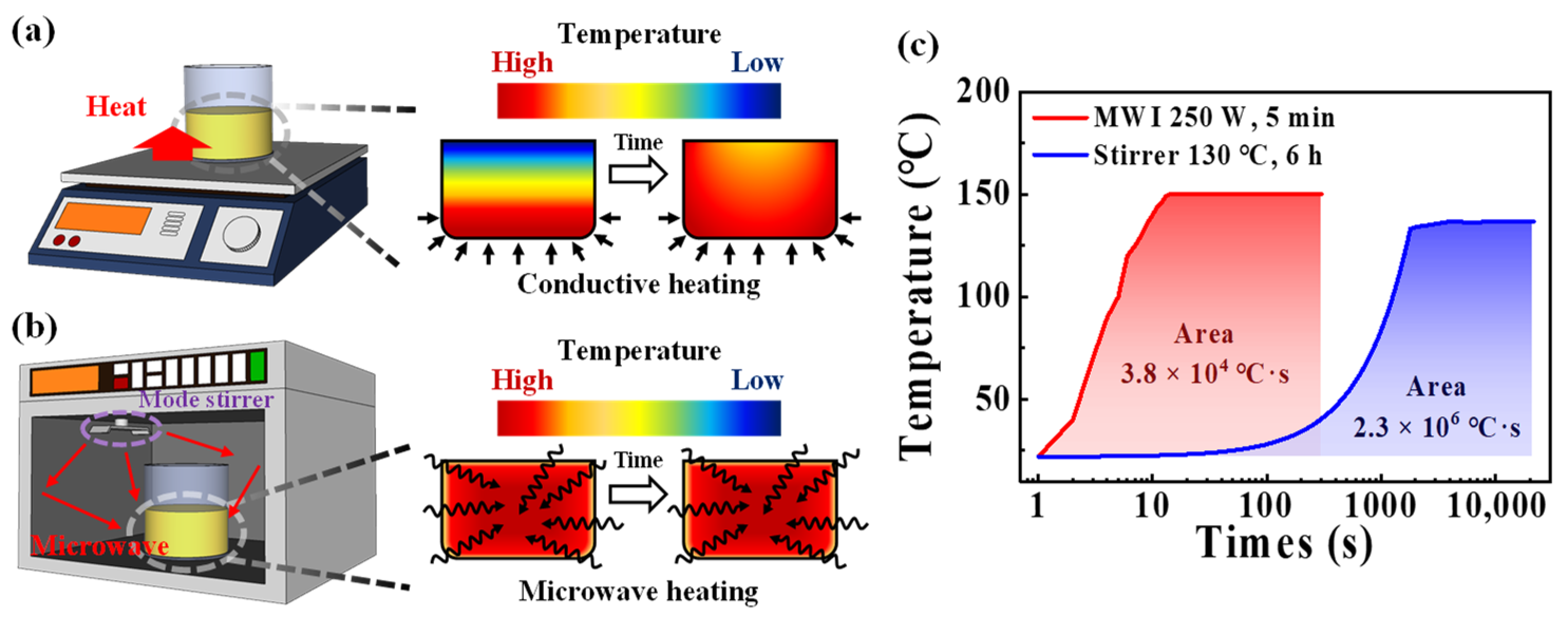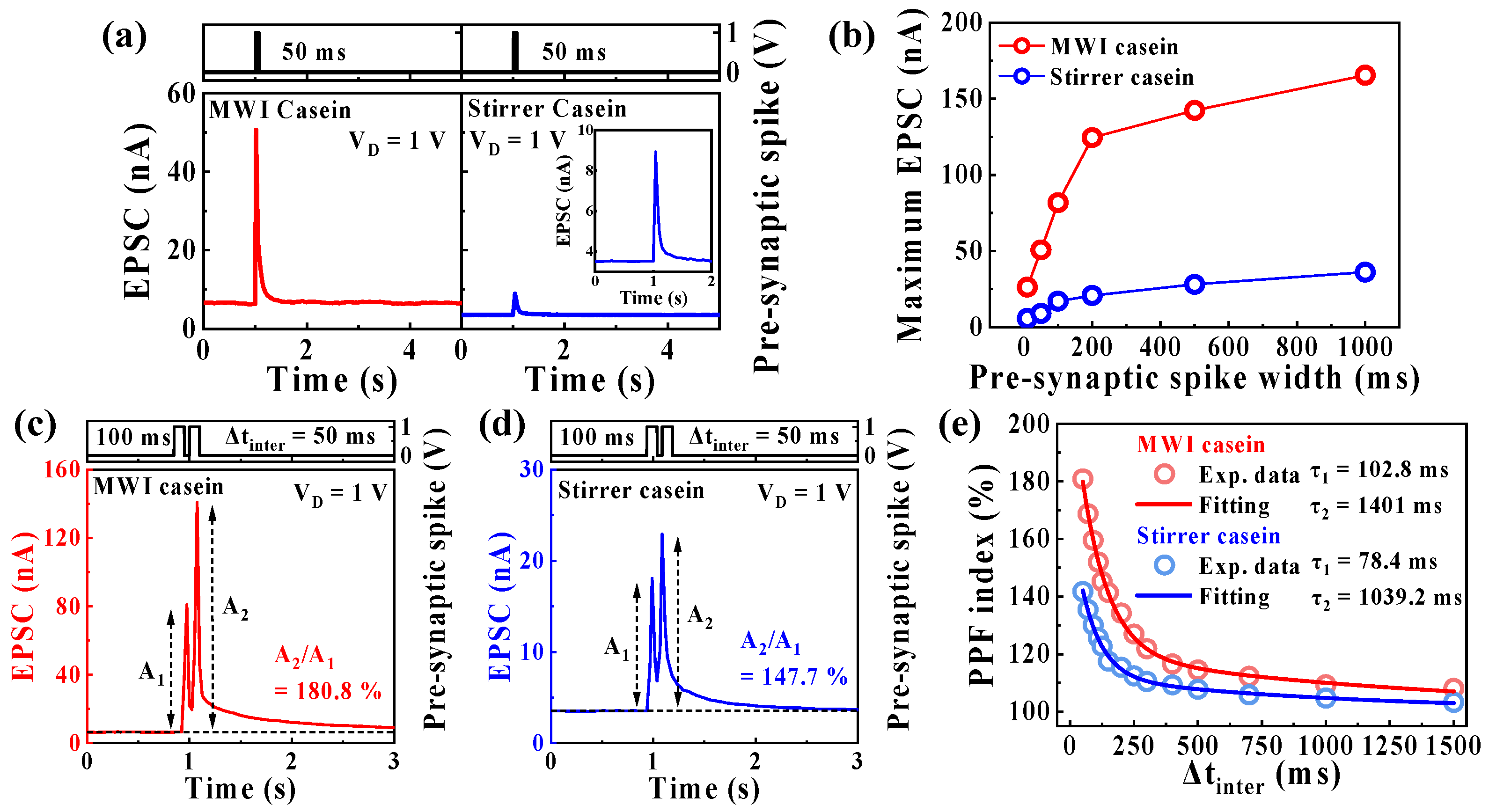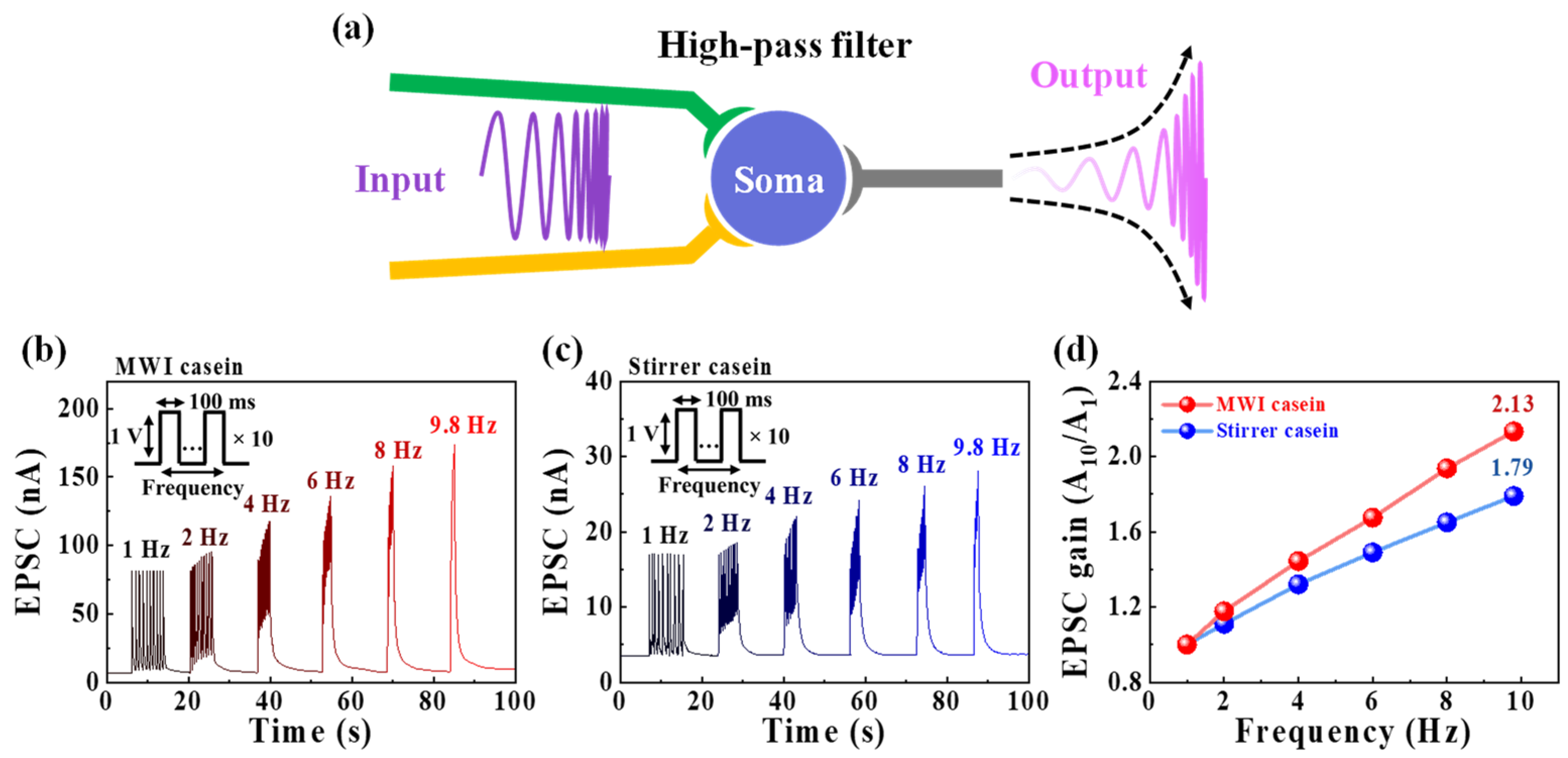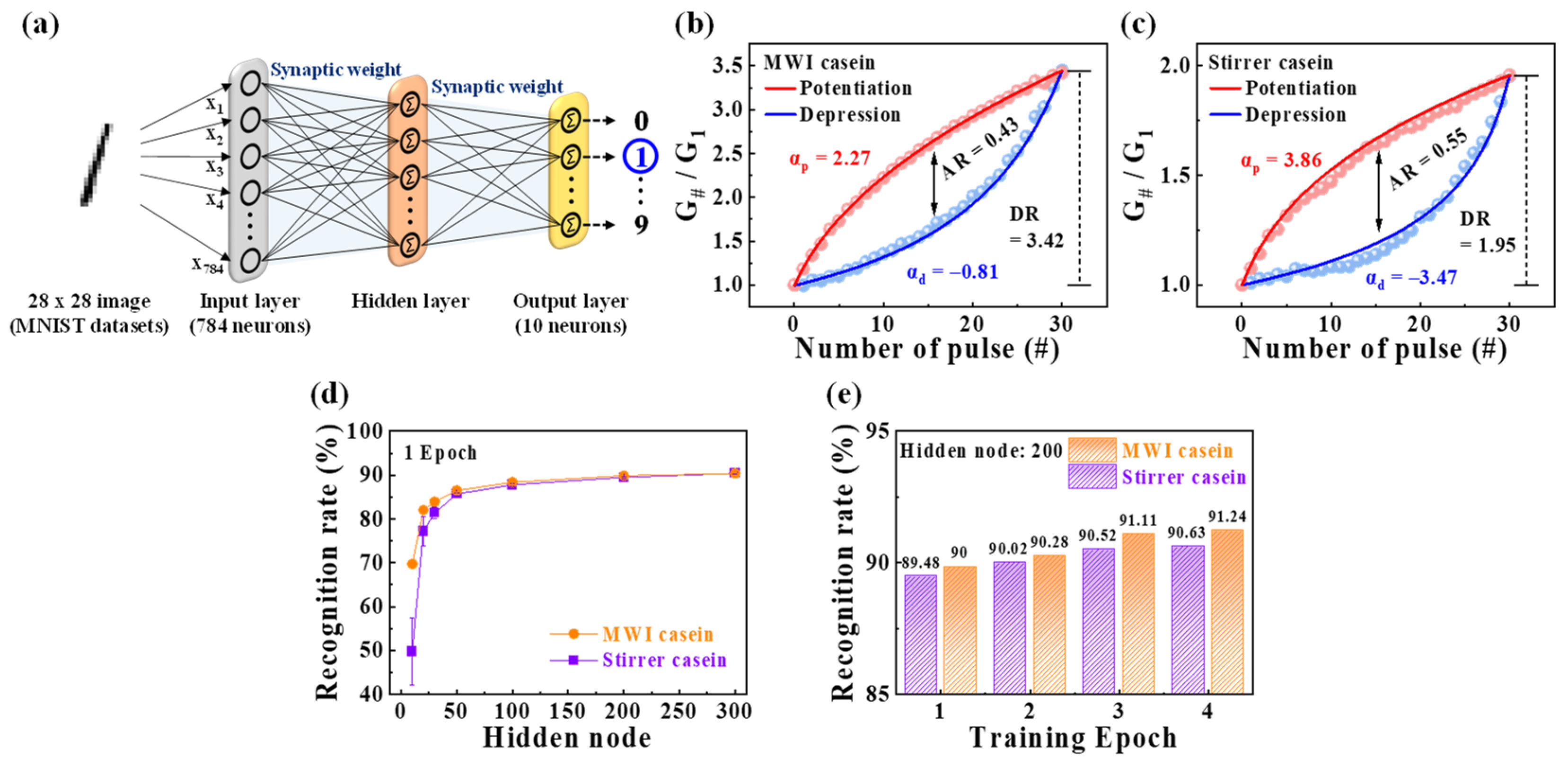Enhanced Synaptic Properties in Biocompatible Casein Electrolyte via Microwave-Assisted Efficient Solution Synthesis
Abstract
1. Introduction
2. Materials and Methods
2.1. Fabrication of Devices
2.2. Characterizations of the Devices
3. Results
3.1. Preparation of a Casein Electrolyte Solution
3.2. EDL Operation of MWI Synthetic Casein Electrolytes
3.3. MWI Synthetic Casein Electrolyte-Gated EDLT
3.4. Electrical Properties of Devices
3.5. Synaptic Properties of Devices
3.6. Recognition Simulation
4. Conclusions
Supplementary Materials
Author Contributions
Funding
Institutional Review Board Statement
Data Availability Statement
Acknowledgments
Conflicts of Interest
References
- Machens, C.K. Neuroscience. Building the human brain. Science 2012, 338, 1156. [Google Scholar] [CrossRef] [PubMed]
- Cole, M.W.; Bassett, D.S.; Power, J.D.; Braver, T.S.; Petersen, S.E. Intrinsic and task-evoked network architectures of the human brain. Neuron 2014, 83, 238. [Google Scholar] [CrossRef] [PubMed]
- Ebbinghaus, H. Memory: A contribution to experimental psychology. Ann. Neurosci. 2013, 20, 155. [Google Scholar] [CrossRef] [PubMed]
- Von Neumann, J. The principles of large-scale computing machines. IEEE Ann. Hist. Comput. 1981, 3, 263. [Google Scholar] [CrossRef]
- Kuzum, D.; Yu, S.; Philip Wong, H.P. Synaptic electronics: Materials, devices and applications. Nanotechnology 2013, 24, 382001. [Google Scholar] [CrossRef] [PubMed]
- Zidan, M.A.; Strachan, J.P.; Lu, W.D. The future of electronics based on memristive systems. Nat. Electron. 2018, 1, 22. [Google Scholar] [CrossRef]
- Jain, A.K.; Mao, J.; Mohiuddin, K.M. Artificial neural networks: A tutorial. Computer 1996, 29, 31. [Google Scholar] [CrossRef]
- Furber, S. Large-scale neuromorphic computing systems. J. Neural Eng. 2016, 13, 051001. [Google Scholar] [CrossRef]
- Jo, S.H.; Chang, T.; Ebong, I.; Bhadviya, B.B.; Mazumder, P.; Lu, W. Nanoscale memristor device as synapse in neuromorphic systems. Nano Lett. 2010, 10, 1297. [Google Scholar] [CrossRef]
- Abbas, H.; Abbas, Y.; Hassan, G.; Sokolov, A.S.; Jeon, Y.R.; Ku, B.; Kang, C.J.; Choi, C. The coexistence of threshold and memory switching characteristics of ALD HfO2 memristor synaptic arrays for energy-efficient neuromorphic computing. Nanoscale 2020, 12, 14120. [Google Scholar] [CrossRef]
- Liu, L.; Xiong, W.; Liu, Y.; Chen, K.; Xu, Z.; Zhou, Y.; Han, J.; Ye, C.; Chen, X.; Song, Z.; et al. Designing high-performance storage in HfO2/BiFeO3 memristor for artificial synapse applications. Adv. Electron. Mater. 2020, 6, 1901012. [Google Scholar] [CrossRef]
- Rajasekaran, S.; Simanjuntak, F.M.; Chandrasekaran, S.; Panda, D.; Saleem, A.; Tseng, T.Y. Flexible ta 2 O 5/WO 3-based memristor synapse for wearable and neuromorphic applications. IEEE Electron Dev. Lett. 2021, 43, 9. [Google Scholar] [CrossRef]
- Covi, E.; Brivio, S.; Serb, A.; Prodromakis, T.; Fanciulli, M.; Spiga, S. HfO2-Based Memristors for Neuromorphic Applications. In Proceedings of the IEEE International Symposium on Circuits and Systems (ISCAS), Montreal, QC, Canada, 22–25 May 2016; Volume 2016, pp. 393–396. [Google Scholar] [CrossRef]
- Fukami, S.; Ohno, H. Perspective: Spintronic synapse for artificial neural network. J. Appl. Phys. 2018, 124, 151904. [Google Scholar] [CrossRef]
- Kuzum, D.; Jeyasingh, R.G.; Lee, B.; Wong, H.S.P. Nanoelectronic programmable synapses based on phase change materials for brain-inspired computing. Nano Lett. 2012, 12, 2179. [Google Scholar] [CrossRef]
- La Barbera, S.; Ly, D.R.B.; Navarro, G.; Castellani, N.; Cueto, O.; Bourgeois, G.; De Salvo, B.; Nowak, E.; Querlioz, D.; Vianello, E. Narrow heater bottom electrode-based phase change memory as a bidirectional artificial synapse. Adv. Electron. Mater. 2018, 4, 1800223. [Google Scholar] [CrossRef]
- Suri, M.; Bichler, O.; Querlioz, D.; Cueto, O.; Perniola, L.; Sousa, V.; Vuillaume, D.; Gamrat, C.; DeSalvo, B. Phase change memory as synapse for ultra-dense neuromorphic systems: Application to complex visual pattern extraction. In Proceedings of the International Electron Devices Meeting, Washington, DC, USA, 5–7 December 2011; Volume 2011, p. 4.4.1. [Google Scholar] [CrossRef]
- Chang, T.C.; Chang, K.C.; Tsai, T.M.; Chu, T.J.; Sze, S.M. Resistance random access memory. Mater. Today 2016, 19, 254. [Google Scholar] [CrossRef]
- Nishitani, Y.; Kaneko, Y.; Ueda, M.; Morie, T.; Fujii, E. Three-terminal ferroelectric synapse device with concurrent learning function for artificial neural networks. J. Appl. Phys. 2012, 111, 124108. [Google Scholar] [CrossRef]
- Monalisha, P.; Kumar, A.P.S.; Wang, X.R.; Piramanayagam, S.N. Emulation of synaptic plasticity on a cobalt-based synaptic transistor for neuromorphic computing. ACS Appl. Mater. Interfaces 2022, 14, 11864. [Google Scholar] [CrossRef]
- Panzer, M.J.; Frisbie, C.D. Exploiting ionic coupling in electronic devices: Electrolyte-gated organic field-effect transistors. Adv. Mater. 2008, 20, 3177. [Google Scholar] [CrossRef]
- Kim, S.H.; Hong, K.; Xie, W.; Lee, K.H.; Zhang, S.; Lodge, T.P.; Frisbie, C.D. Electrolyte-gated transistors for organic and printed electronics. Adv. Mater. 2013, 25, 1822. [Google Scholar] [CrossRef]
- Yuan, H.; Shimotani, H.; Ye, J.; Yoon, S.; Aliah, H.; Tsukazaki, A.; Kawasaki, M.; Iwasa, Y. Electrostatic and electrochemical nature of liquid-gated electric-double-layer transistors based on oxide semiconductors. J. Am. Chem. Soc. 2010, 132, 18402. [Google Scholar] [CrossRef] [PubMed]
- Liu, Y.; Wan, X.; Zhu, L.Q.; Shi, Y.; Wan, Q. Laterally coupled dual-gate oxide-based transistors on sodium alginate electrolytes. IEEE Electron Dev. Lett. 2014, 35, 1257. [Google Scholar] [CrossRef]
- Wan, C.J.; Zhu, L.Q.; Wan, X.; Shi, Y.; Wan, Q. Organic/inorganic hybrid synaptic transistors gated by proton conducting methylcellulose films. Appl. Phys. Lett. 2016, 108, 043508. [Google Scholar] [CrossRef]
- Liu, Y.H.; Qiang Zhu, L.; Shi, Y.; Wan, Q. Proton conducting sodium alginate electrolyte laterally coupled low-voltage oxide-based transistors. Appl. Phys. Lett. 2014, 104, 133504. [Google Scholar] [CrossRef]
- Liu, Y.H.; Zhu, L.Q.; Feng, P.; Shi, Y.; Wan, Q. Freestanding artificial synapses based on laterally proton-coupled transistors on chitosan membranes. Adv. Mater. 2015, 27, 5599. [Google Scholar] [CrossRef] [PubMed]
- Liu, R.; Zhu, L.Q.; Wang, W.; Hui, X.; Liu, Z.P.; Wan, Q. Biodegradable oxide synaptic transistors gated by a biopolymer electrolyte. J. Mater. Chem. C 2016, 4, 7744. [Google Scholar] [CrossRef]
- Gao, W.T.; Zhu, L.Q.; Tao, J.; Wan, D.Y.; Xiao, H.; Yu, F. Dendrite integration mimicked on starch-based electrolyte-gated oxide dendrite transistors. ACS Appl. Mater. Interfaces 2018, 10, 40008. [Google Scholar] [CrossRef]
- Guo, Y.B.; Zhu, L.Q.; Long, T.Y.; Wan, D.Y.; Ren, Z.Y. Bio-polysaccharide electrolyte gated photoelectric synergic coupled oxide neuromorphic transistor with Pavlovian activities. J. Mater. Chem. C 2020, 8, 2780–2789. [Google Scholar] [CrossRef]
- He, Y.; Sun, J.; Qian, C.; Kong, L.A.; Jiang, J.; Yang, J.; Li, H.; Gao, Y. Solution-processed natural gelatin was used as a gate dielectric for the fabrication of oxide field-effect transistors. Org. Electron. 2016, 38, 357. [Google Scholar] [CrossRef]
- Lai, D.; Li, E.; Yan, Y.; Liu, Y.; Zhong, J.; Lv, D.; Ke, Y.; Chen, H.; Guo, T. Gelatin-hydrogel based organic synaptic transistor. Org. Electron. 2019, 75, 105409. [Google Scholar] [CrossRef]
- Wen, J.; Zhu, L.Q.; Qi, H.F.; Ren, Z.Y.; Wang, F.; Xiao, H. Brain-inspired biodegradable pectin based proton conductor gated electronic synapse. Org. Electron. 2020, 82, 105782. [Google Scholar] [CrossRef]
- Kim, H.S.; Park, H.; Cho, W.J. Biocompatible casein electrolyte-based electric-double-layer for artificial synaptic transistors. Nanomaterials 2022, 12, 2596. [Google Scholar] [CrossRef] [PubMed]
- Gedye, R.; Smith, F.; Westaway, K.; Ali, H.; Baldisera, L.; Laberge, L.; Rousell, J. The use of microwave ovens for rapid organic synthesis. Tetrahedron Lett. 1986, 27, 279–282. [Google Scholar] [CrossRef]
- Surati, M.A.; Jauhari, S.; Desai, K.R. A brief review: Microwave assisted organic reaction. Arch. Appl. Sci. Res. 2012, 4, 645–661. [Google Scholar]
- Nüchter, M.; Ondruschka, B.; Bonrath, W.; Gum, A. Microwave assisted synthesis–a critical technology overview. Green Chem. 2004, 6, 128–141. [Google Scholar] [CrossRef]
- Kappe, C.O. High-speed combinatorial synthesis utilizing microwave irradiation. Curr. Opin. Chem. Biol. 2002, 6, 314. [Google Scholar] [CrossRef]
- Ge, H.C.; Luo, D.K. Preparation of carboxymethyl chitosan in aqueous solution under microwave irradiation. Carbohydr. Res. 2005, 340, 1351. [Google Scholar] [CrossRef] [PubMed]
- Yu, H.P.; Zhu, Y.J.; Lu, B.Q. Highly efficient and environmentally friendly microwave-assisted hydrothermal rapid synthesis of ultralong hydroxyapatite nanowires. Ceram. Int. 2018, 44, 12352. [Google Scholar] [CrossRef]
- Nomanbhay, S.; Ong, M.Y. A review of microwave-assisted reactions for biodiesel production. Bioengineering 2017, 4, 57. [Google Scholar] [CrossRef]
- Akbarian-Tefaghi, S.; Wiley, J.B. Microwave-assisted routes for rapid and efficient modification of layered perovskites. Dalton Trans. 2018, 47, 2917. [Google Scholar] [CrossRef]
- Long, T.Y.; Zhu, L.Q.; Ren, Z.Y.; Guo, Y.B. Global modulatory heterosynaptic mechanisms in bio-polymer electrolyte gated oxide neuron transistors. J. Phys. D Appl. Phys. 2020, 53, 435105. [Google Scholar] [CrossRef]
- Cordeschi, M.; Di Paola, L.; Marrelli, L.; Maschietti, M. Net proton charge of β- and κ-casein in concentrated aqueous electrolyte solutions. Biophys. Chem. 2003, 103, 77. [Google Scholar] [CrossRef] [PubMed]
- Szyk-Warszyńska, L.; Raszka, K.; Warszyński, P. Interactions of casein and polypeptides in multilayer films studied by FTIR and molecular dynamics. Polymers 2019, 11, 920. [Google Scholar] [CrossRef] [PubMed]
- Curley, D.M.; Kumosinski, T.F.; Unruh, J.J.; Farrell, H.M., Jr. Changes in the secondary structure of bovine casein by Fourier transform infrared spectroscopy: Effects of calcium and temperature. J. Dairy Sci. 1998, 81, 3154. [Google Scholar] [CrossRef] [PubMed]
- Fadzallah, I.A.; Majid, S.R.; Careem, M.A.; Arof, A.K. A study on ionic interactions in chitosan–oxalic acid polymer electrolyte membranes. J. Membr. Sci. 2014, 463, 65. [Google Scholar] [CrossRef]
- Qin, L.; Bi, J.R.; Li, D.M.; Dong, M.; Zhao, Z.Y.; Dong, X.P.; Zhou, D.Y.; Zhu, B.W. Unfolding/refolding study on collagen from sea cucumber based on 2D fourier transform infrared spectroscopy. Molecules 2016, 21, 1546. [Google Scholar] [CrossRef]
- Dallinger, D.; Kappe, C.O. Microwave-assisted synthesis in water as solvent. Chem. Rev. 2007, 107, 2563–2591. [Google Scholar] [CrossRef]
- Li, Y.; Cai, L.; Chen, H.; Liu, Z.; Zhang, X.; Li, J.; Shi, S.Q.; Li, J.; Gao, Q. Preparation of a high bonding performance soybean protein-based adhesive with low crosslinker addition via microwave chemistry. Int. J. Biol. Macromol. 2022, 208, 45–55. [Google Scholar] [CrossRef]
- Fujimoto, T.; Awaga, K. Electric-double-layer field-effect transistors with ionic liquids. Phys. Chem. Chem. Phys. 2013, 15, 8983. [Google Scholar] [CrossRef]
- Drachman, D.A. Do we have brain to spare? Neurology 2005, 64, 2004. [Google Scholar] [CrossRef]
- Zucker, R.S.; Regehr, W.G. Short-term synaptic plasticity. Annu. Rev. Physiol. 2002, 64, 355. [Google Scholar] [CrossRef]
- Guo, L.; Zhang, G.; Han, H.; Hu, Y.; Cheng, G. Light/electric modulated approach for logic functions and artificial synapse behaviors by flexible IGZO TFTs with low power consumption. J. Phys. D Appl. Phys. 2022, 55, 195108. [Google Scholar] [CrossRef]
- Zhao, S.; Ni, Z.; Tan, H.; Wang, Y.; Jin, H.; Nie, T.; Xu, M.; Pi, X.; Yang, D. Electroluminescent synaptic devices with logic functions. Nano Energy 2018, 54, 383. [Google Scholar] [CrossRef]
- Huang, J.; Chen, J.; Yu, R.; Zhou, Y.; Yang, Q.; Li, E.; Chen, Q.; Chen, H.; Guo, T. Tuning the synaptic behaviors of biocompatible synaptic transistor through ion-doping. Org. Electron. 2021, 89, 106019. [Google Scholar] [CrossRef]
- Feng, P.; Xu, W.; Yang, Y.; Wan, X.; Shi, Y.; Wan, Q.; Zhao, J.; Cui, Z. Printed neuromorphic devices based on printed carbon nanotube thin-film transistors. Adv. Funct. Mater. 2017, 27, 1604447. [Google Scholar] [CrossRef]
- Ohno, T.; Hasegawa, T.; Tsuruoka, T.; Terabe, K.; Gimzewski, J.K.; Aono, M. Short-term plasticity and long-term potentiation mimicked in single inorganic synapses. Nat. Mater. 2011, 10, 591. [Google Scholar] [CrossRef] [PubMed]
- Bliss, T.V.; Collingridge, G.L. A synaptic model of memory: Long-term potentiation in the hippocampus. Nature 1993, 361, 31. [Google Scholar] [CrossRef]
- Jang, J.W.; Park, S.; Burr, G.W.; Hwang, H.; Jeong, Y.H. Optimization of conductance change in Pr 1–x Ca x MnO 3-based synaptic devices for neuromorphic systems. IEEE Electron Device Lett. 2015, 36, 457–459. [Google Scholar] [CrossRef]
- Chen, X.; Li, E.; Zhang, X.; Chen, Q.; Yu, R.; Ye, Y.; Chen, H.; Guo, T. Printed Organic Synaptic Transistor Array for One-to-Many Neural Response. IEEE Electron Device Lett. 2022, 43, 394–397. [Google Scholar] [CrossRef]
- Wang, C.; Li, Y.; Wang, Y.; Xu, X.; Fu, M.; Liu, Y.; Lin, Z.; Ling, H.; Gkoupidenis, P.; Yi, M.; et al. Thin-film transistors for emerging neuromorphic electronics: Fundamentals, materials, and pattern recognition. J. Mater. Chem. C 2021, 9, 11464. [Google Scholar] [CrossRef]
- Jang, J.W.; Park, S.; Jeong, Y.H.; Hwang, H. ReRAM-based synaptic device for neuromorphic computing. In Proceedings of the IEEE International Symposium on Circuits and Systems (ISCAS), Melbourne, VIC, Australia, 1–5 June 2014; Volume 2014, pp. 1054–1057. [Google Scholar] [CrossRef]








| EDL Type | Ion/Ioff (A/A) | Vth (V) | ΔV (V) | SS (mV/dec) | μFE (cm2/V·s) | Dit (cm2·eV−1) |
|---|---|---|---|---|---|---|
| MWI casein | 4.31 × 107 | 0.61 | 2.51 | 131.59 | 18.62 | 1.88 × 1011 |
| Heat stirrer casein | 4.12 × 106 | 0.99 | 1.75 | 332.87 | 2.24 | 2.03 × 1011 |
| Biopolymer EDL | Synthesis Condition | Capacitance at 1 Hz | Ion/Ioff | SS | PPF Index | Ref. |
|---|---|---|---|---|---|---|
| Starch | Heat-stirrer (90 °C, 30 min) | ~1.5 μF/cm2 | ~1.6 × 106 A/A | ~140 mV/dec | ~162% (Δtinter = 10 ms) | [30] |
| Pectin | Heat-stirrer (70 °C, 30 min) | ~3.7 μF/cm2 | ~6.6 × 105 A/A | ~196 mV/dec | ~150% (Δtinter = 10 ms) | [33] |
| PVA | Heat-stirrer (100 °C, 4 h) | ~1.63 μF/cm2 | ~7.8 × 106 A/A | ~129.7 mV/dec | ~123% (Δtinter = 50 ms) | [54] |
| Casein | MWI 250 W (≈150 °C, 5 min) | ~3.58 μF/cm2 | ~4.31 × 107 A/A | ~131.59 mV/dec | ~180% (Δtinter = 50 ms) | This work |
Disclaimer/Publisher’s Note: The statements, opinions and data contained in all publications are solely those of the individual author(s) and contributor(s) and not of MDPI and/or the editor(s). MDPI and/or the editor(s) disclaim responsibility for any injury to people or property resulting from any ideas, methods, instructions or products referred to in the content. |
© 2023 by the authors. Licensee MDPI, Basel, Switzerland. This article is an open access article distributed under the terms and conditions of the Creative Commons Attribution (CC BY) license (https://creativecommons.org/licenses/by/4.0/).
Share and Cite
Kim, H.-S.; Park, H.; Cho, W.-J. Enhanced Synaptic Properties in Biocompatible Casein Electrolyte via Microwave-Assisted Efficient Solution Synthesis. Polymers 2023, 15, 293. https://doi.org/10.3390/polym15020293
Kim H-S, Park H, Cho W-J. Enhanced Synaptic Properties in Biocompatible Casein Electrolyte via Microwave-Assisted Efficient Solution Synthesis. Polymers. 2023; 15(2):293. https://doi.org/10.3390/polym15020293
Chicago/Turabian StyleKim, Hwi-Su, Hamin Park, and Won-Ju Cho. 2023. "Enhanced Synaptic Properties in Biocompatible Casein Electrolyte via Microwave-Assisted Efficient Solution Synthesis" Polymers 15, no. 2: 293. https://doi.org/10.3390/polym15020293
APA StyleKim, H.-S., Park, H., & Cho, W.-J. (2023). Enhanced Synaptic Properties in Biocompatible Casein Electrolyte via Microwave-Assisted Efficient Solution Synthesis. Polymers, 15(2), 293. https://doi.org/10.3390/polym15020293








